Amazon Fire TV Stick
An Amazon Fire TV Stick is a compact consumer streaming player that can run signage apps and act as a low-cost digital signage player. In signage contexts it connects to content platforms like Fugo.ai, rendering playlists, dashboards and interactive content over HDMI while relying on Wi-Fi, Fire OS and app-based management for remote updates and control.
What is Amazon Fire TV Stick?
Technical considerations: Fire OS, app model and performance characteristics
Fire TV Sticks run a customised version of Android called Fire OS, and that runtime environment shapes how signage applications are deployed, managed and monitored. From a technical perspective the device is an app-first platform: signage software typically runs as an APK installed either through the Amazon Appstore, sideloaded with ADB, or installed via an MDM solution that supports Android-based devices. This app model means the signage capability depends heavily on the application’s ability to cache media, handle offline scenarios, and manage playlists within the constrained memory and CPU profile of a stick-class device. For example, a playlist that mixes full-screen video, live data widgets and high-frequency images will need a player that actively manages memory and preloads next media items to avoid stutters during transitions. Fire TV Stick variants such as the Lite, 4K or 4K Max have different SoC and GPU capabilities; the 4K Max offers more headroom for high-bitrate 4K video but still shares the same basic app lifecycle and background process limits as other sticks. Networking and storage behaviour is another technical layer to account for. Sticks primarily use Wi-Fi, so signage implementations should engineer for network resilience: use reserved DHCP leases, set robust DNS and supply fallback content or compressed assets when bandwidth is limited. Local caching strategies are essential — signage players like Fugo’s client will typically download and keep a rolling cache of media on the device’s internal storage, evicting older content based on configured thresholds. From a security and manageability standpoint, Fire OS provides support for device policies when the player is provisioned as device owner via ADB or an MDM; this enables kiosk-like single-app mode, disables remote discovery options, and restricts user access to system UI. For operations teams, remote logging and health metrics (CPU, memory, uptime, last asset refresh) are invaluable; many signage platforms include telemetry that can be collected from the Fire TV Stick app or via an agent, allowing proactive fault detection and automated reboots if necessary.
Deployment and management: practical steps for large-scale Fire TV Stick signage estates
Deploying Fire TV Sticks at scale for digital signage requires a disciplined approach to provisioning, power, network and lifecycle. Begin with a repeatable provisioning workflow: unbox devices, update Fire OS to the latest firmware, sideload or install the signage app, and configure the app to enrol with your cloud CMS, such as Fugo.ai. Automating enrolment using ADB scripts or an MDM reduces manual steps; for example, configuring devices as device owner lets you lock the player into a kiosk state so tampering is minimised. Power is a common pitfall: many installers rely on TV USB ports which can cut power when the screen is off or sleep, causing the player to restart unpredictably. Use a dedicated USB power supply with a reliable current rating and prevent power cycling by disabling TV USB power management where possible. Another frequent issue is thermal throttling in enclosed installations; ensure adequate ventilation and avoid mounting sticks behind screens where heat buildup is likely. Monitoring and optimisation are continuous activities in a signage estate. Implement centralised device monitoring for status checks, asset sync timestamps, network connectivity and available storage. Fugo.ai and similar platforms provide dashboards to group devices, push updates, and trigger remote reboots or cache clears when needed. Content optimisation reduces incidents: transcode video to device-friendly codecs, use appropriately sized images to limit download times, and configure staging playlists to validate new content before full roll-out. When dealing with interactive or data-driven dashboards, validate the refresh intervals and API rate limits to avoid overloading both network and the device. Finally, plan for replacements and firmware drift: consumer-class Fire TV Sticks can stop receiving updates or become obsolete; maintain an inventory with OS versions and end-of-support dates, and budget for periodic refreshes or migration to commercial-grade players for critical displays.
Final Thoughts on Amazon Fire TV Stick
Keep the learning going...
All-in-one signage devices
All-in-one signage devices are compact displays with an integrated media player and operating system designed for digital signage. They reduce cabling, simplify rollouts and centralise management, making them well suited to TV dashboards and workplace displays that connect to platforms like Fugo.ai for content automation and remote monitoring.
Ambient light sensors
Ambient light sensors are hardware devices or integrated system sensors that detect environmental illumination and report lux or correlated colour temperature values. In digital signage contexts they enable automatic brightness and colour adjustments, reduce power consumption, and maintain consistent visual quality across diverse locations and viewing conditions.
Ambilight effects
Ambilight effects are dynamic ambient lighting techniques that extend on-screen visuals into the surrounding environment by sampling or analysing content and driving LED or display lighting. In digital signage they boost perceived contrast and brand presence, reduce eye strain, and create immersive dashboards and workplace displays that react to scheduled or live content.



